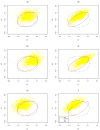Asymptotic tests of association with multiple SNPs in linkage disequilibrium
- PMID: 19170135
- PMCID: PMC2732754
- DOI: 10.1002/gepi.20402
Asymptotic tests of association with multiple SNPs in linkage disequilibrium
Abstract
We consider detecting associations between a trait and multiple single nucleotide polymorphisms (SNPs) in linkage disequilibrium (LD). To maximize the use of information contained in multiple SNPs while minimizing the cost of large degrees of freedom (DF) in testing multiple parameters, we first theoretically explore the sum test derived under a working assumption of a common association strength between the trait and each SNP, testing on the corresponding parameter with only one DF. Under the scenarios that the association strengths between the trait and the SNPs are close to each other (and in the same direction), as considered by Wang and Elston [Am. J. Hum. Genet. [2007] 80:353-360], we show with simulated data that the sum test was powerful as compared to several existing tests; otherwise, the sum test might have much reduced power. To overcome the limitation of the sum test, based on our theoretical analysis of the sum test, we propose five new tests that are closely related to each other and are shown to consistently perform similarly well across a wide range of scenarios. We point out the close connection of the proposed tests to the Goeman test. Furthermore, we derive the asymptotic distributions of the proposed tests so that P-values can be easily calculated, in contrast to the use of computationally demanding permutations or simulations for the Goeman test. A distinguishing feature of the five new tests is their use of a diagonal working covariance matrix, rather than a full covariance matrix as used in the usual Wald or score test. We recommend the routine use of two of the new tests, along with several other tests, to detect disease associations with multiple linked SNPs.
Figures
Similar articles
-
Analysis of multiple SNPs in a candidate gene or region.Genet Epidemiol. 2008 Sep;32(6):560-6. doi: 10.1002/gepi.20330. Genet Epidemiol. 2008. PMID: 18428428 Free PMC article.
-
Detecting genetic association through shortest paths in a bidirected graph.Genet Epidemiol. 2017 Sep;41(6):481-497. doi: 10.1002/gepi.22051. Epub 2017 Jun 19. Genet Epidemiol. 2017. PMID: 28626864 Free PMC article.
-
Family-based association tests for qualitative and quantitative traits using single-nucleotide polymorphism and microsatellite data.Genet Epidemiol. 2001;21 Suppl 1:S364-9. doi: 10.1002/gepi.2001.21.s1.s364. Genet Epidemiol. 2001. PMID: 11793700
-
Haplotype-based methods for detecting uncommon causal variants with common SNPs.Genet Epidemiol. 2012 Sep;36(6):572-82. doi: 10.1002/gepi.21650. Epub 2012 Jun 15. Genet Epidemiol. 2012. PMID: 22706849 Free PMC article.
-
Improved power by use of a weighted score test for linkage disequilibrium mapping.Am J Hum Genet. 2007 Feb;80(2):353-60. doi: 10.1086/511312. Epub 2006 Dec 21. Am J Hum Genet. 2007. PMID: 17236140 Free PMC article.
Cited by
-
Utilizing mutual information for detecting rare and common variants associated with a categorical trait.PeerJ. 2016 Jun 16;4:e2139. doi: 10.7717/peerj.2139. eCollection 2016. PeerJ. 2016. PMID: 27350900 Free PMC article.
-
Unified model-free interaction screening via CV-entropy filter.Comput Stat Data Anal. 2023 Apr;180:107684. doi: 10.1016/j.csda.2022.107684. Epub 2022 Dec 28. Comput Stat Data Anal. 2023. PMID: 36910335 Free PMC article.
-
Genome-wide association study for multiple phenotype analysis.BMC Proc. 2018 Sep 17;12(Suppl 9):55. doi: 10.1186/s12919-018-0135-8. eCollection 2018. BMC Proc. 2018. PMID: 30263053 Free PMC article.
-
A linear mixed model framework for gene-based gene-environment interaction tests in twin studies.Genet Epidemiol. 2018 Oct;42(7):648-663. doi: 10.1002/gepi.22150. Epub 2018 Sep 11. Genet Epidemiol. 2018. PMID: 30203856 Free PMC article.
-
Statistical tests of genetic association in the presence of gene-gene and gene-environment interactions.Hum Hered. 2010;69(2):131-42. doi: 10.1159/000264450. Epub 2009 Dec 4. Hum Hered. 2010. PMID: 19996610 Free PMC article.
References
-
- Chapman JM, Cooper JD, Todd JA, Clayton DG. Detecting disease associations due to linkage disequilibrium using haplotype tags: a class of tests and the determinants of statistical power. Hum Hered. 2003;56:18–31. - PubMed
-
- Clayton D, Chapman J, Cooper J. Use of unphased multilocus genotype data in indirect association studies. Genet Epidemiol. 2004;27:415–428. - PubMed
-
- Cox DR, Hinkley DV. Theoretical Statistics. Chapman and Hall; London: 1974.
Publication types
MeSH terms
Grants and funding
LinkOut - more resources
Full Text Sources
Research Materials
Miscellaneous


